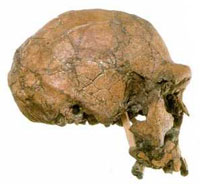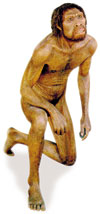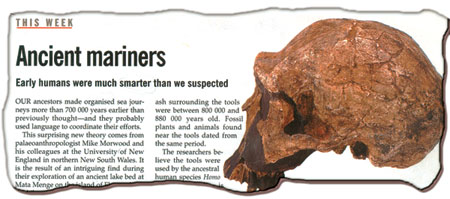In the scheme of "man's evolution" devised by evolutionists, fossils classified as Homo erectus come after the Australopithecus species. (The classification, "Homo habilis", which was proposed by certain evolutionists, has been included in the Australopithecus species in recent years.)
 | A typical Homo erectus skull found in Koobi Fora in Africa in 1975. |  |
A skull dating back some 13,000 years unearthed in Kow Swamp in Australia that has the characteristics of both modern man and Homo erectus. |
As the word "erect" implies, "Homo erectus" means a "man walking upright". Evolutionists have had to separate these men from previous ones by adding the quality of "erectness", because all the available Homo erectus fossils are straight to an extent not observed in any of the Australopithecus or Homo habilis specimens. There is no difference between the skeleton of modern man and that of Homo erectus.
 | TURKANA BOY "Tall and modern". That was the comment Richard Leakey made on this fossil dating back 2.2 million years. There is virtually no difference between this fossil classified as Homo erectus and the modern human skeleton. | MODERN HOMO ERECTUS In its 23 December 1996 issue, Time magazine covered a 27,000-year-old Homo erectus found on the Island of Java. The fact that Homo erectus existed till very recent times is evidence that it is not a different species but a modern human race. |  |
A good indication of this is the "Turkana Boy" fossil that is included in the Homo erectus class. It is confirmed that the fossil was of a 12-year-old boy, who would have been 1.83 meters tall in his adolescence. The upright skeleton structure of the fossil is no different from that of modern man, on which point American paleoanthropologist Alan Walker said that he doubted that "the average pathologist could tell the difference between the fossil skeleton and that of a modern human."52
 | MARINE ENGINEER HOMO ERECTUS News published in New Scientist on March 14th, 1998, tells us that the humans called Homo Erectus by evolutionists were practicing seamanship 700,000 years ago. These humans, who had enough knowledge and technology to build a vessel and possess a culture that made use of sea transport, can hardly be called primitive. Fossil findings of Homo erectus show that this classification is of a real human race. |
The primary reason for evolutionists to define Homo erectus as "primitive" is the cranial capacity of its skull (900-1100 cc), which is smaller than that of the average modern man, and its thick eyebrow projections. However, there are many people living today in the world who have the same cranial capacity as Homo erectus (for instance the pygmies) and there are some other races that have protruding eyebrows (for instance the Australian Aborigines).
 |
AUSTRALIAN NATIVE PEOPLE Aborigines, the native people of Australia, who are still living today, have great similarities to Homo erectus in terms of their cranial features. |
It is a commonly agreed fact that differences in cranial capacity do not necessarily denote differences in intelligence or abilities. Intelligence depends on the internal organisation of the brain rather than its volume.53
Even evolutionist Richard Leakey states that the differences between Homo erectus and modern man are no more than racial variance:
"One would also see differences in the shape of the skull, in the degree of protrusion of the face, the robustness of the brows and so on. These differences are probably no more pronounced than we see today between the separate geographical races of modern humans."54
In short, human beings, whom evolutionists classify as Homo erectus, are a lost human race whose level of intelligence is no different from our own. There is, on the other hand, a huge gap between Homo erectus, a human race, and the apes that preceded it in the "human evolution" scenario, (Australopithecus, or Homo habilis). This means that the first men appeared in the fossil record suddenly and right away without any evolutionary history. There can be no clearer indication of their being created.
54) Boyce Rensberger, The Washington Post, 19 November 1984
55) Marvin Lubenow, Bones of Contention, Grand Rapids, Baker, 1992, S. 83
56) Richard Leakey, The Making of Mankind, London: Sphere Books, 1981, S. 62